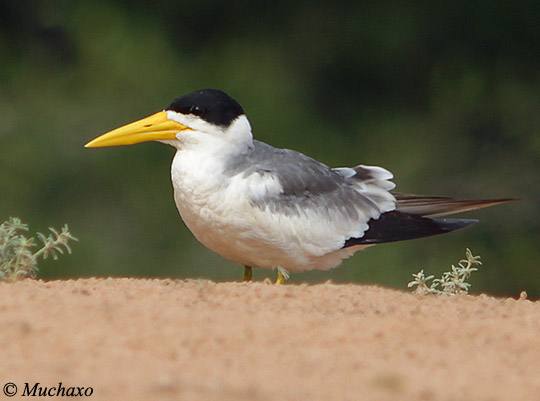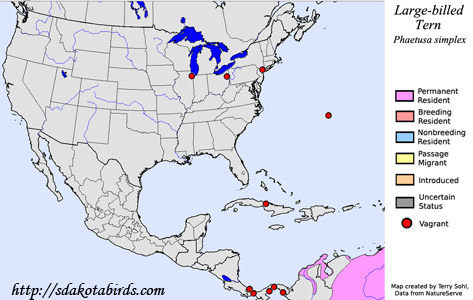| Length: 14 to 15 inches | Wingspan: 34 to 36 inches | Seasonality: Non-resident in South Dakota |
| ID Keys: Heavy, large, yellow bill, black cap, white underparts, dark grey back, obvious black primaries | ||
 The
Large-billed Tern is an easily identifiable tern species with a normal range
that covers much of South America. The only member of the Phaetusa
genus, they are easily identified by the heavy yellow bill, and the striking
plumage visible in flight with black primaries, white secondaries, and a
dark grey back. They are only rare visitors outside of South America,
but have been found in Cuba, Bermuda, and in a few scattered locations in
the United States.
The
Large-billed Tern is an easily identifiable tern species with a normal range
that covers much of South America. The only member of the Phaetusa
genus, they are easily identified by the heavy yellow bill, and the striking
plumage visible in flight with black primaries, white secondaries, and a
dark grey back. They are only rare visitors outside of South America,
but have been found in Cuba, Bermuda, and in a few scattered locations in
the United States.
Habitat: During the breeding season they are found on sandy shorelines and sandbars of inland lakes and rivers, or near coastal estuaries. While found on coastlines at all seasons, they are more common there after breeding season concludes.
Diet: Feeds on a variety of aquatic creatures and insects. Fish are a major prey item, but so are aquatic invertebrates. They will also capture insects in flight.
Behavior: Foraging includes plunge diving for fish and other aquatic prey, skimming the surface while in flight, or capturing insects on the wing.
Nesting: Breeding often occurs in mixed colonies with Black Skimmers and other tern species. They nest near sandy shorelines of freshwater lakes and rivers, with eggs laid directly in hidden locations with grasses or other vegetation. Two eggs are laid, with both parents sharing incubation duties that may last up to 30 days. Both parents help feed and protect the young once they hatch.
Song: Very vocal birds, can often be heard making various loud honking calls and quieter clucking calls.
Migration: While generally considered a permanent resident throughout most of their range, they do obviously disperse after nesting season is complete, with post-breeding birds found in greater variety of aquatic habitats than breeding birds. Numbers of Large-billed Terns along coastlines increase during the non-breeding sesaon.
Interactive eBird Map: Click here to access an interactive eBird map of Large-billed Tern sightings
Similar Species: Unique plumage in flight and massive yellow bill make them unlikely to be mistaken for another species if seen well.
Conservation Status: Populations are considered stable, and the IUCN lists the Large-billed Tern as a species of "Least Concern"
Further Information: 1) BirdLife International - Large-billed Tern
2) WhatBird.org - Large-billed Tern
3) Cornell's Neotropical Birds - Large-billed Tern
Photo Information: Photo taken by Muchaxo - September 20th, 2012 - Pantanal - Photo licensed under Creative Commons Attribution-NonCommercial-ShareAlike 2.0 Generic License
| Click below for a higher-resolution map |
 |
| South Dakota Status: Non-resident in South Dakota |
Additional Large-billed Tern Photos (Coming soon...)
